In this section you will learn to:
- Regularly provide information about WHS policies and procedures to the work team
- Provide information about identified hazards and the outcomes of risk assessment and risk controls to the work team
- Monitor housekeeping practices to ensure that WHS policies and procedures are followed
- Maintain WHS incident records in the work area according to workplace procedures and legislative requirements
- Report health and safety issues in line with workplace procedures and legislative requirements
Supplementary materials relevant to this section:
- Reading E: Information Sheet Incident Notification
The previous section of the module introduced you to WHS policies, procedures, and legislation and how to identify hazards and control risks. In this Section, you will learn how to implement WHS policies and procedures into work team processes, including monitoring and documentation processes.
Watch

As mentioned previously, WHS risks and hazards can impact everyone who works at an organisation, and following and maintaining WHS standards is everyone’s responsibility. The following will outline important aspects of sharing WHS related information with your work team within an organisation.
Information on WHS policies and procedures
It is important for workers to share information with each other on WHS practices and procedures. When there is a new member to the work team, they may not be aware of their role and responsibilities in regard to reporting hazards, so it is vital that information on safe work practices and policies are regularly shared among team members. These avenues may be through:
- Meetings regarding WHS policies and procedures
- Presenting information on changes and updates through noticeboards, electronic or otherwise, and email correspondence
- Explaining policies and procedures during induction of new staff members
- Providing refresher training where appropriate
- Creating or providing a video presenting relevant information on policies and procedures
Not sharing relevant information could potentially result in an increase in the likelihood of a hazard occurring in the workplace. Examples of the types of information you can share with work colleagues include details of:
- Hazards, incidents, and investigation reports
- Workplace inspection reports
- Incident investigation reports
- Minutes of meetings
- Job Safety Analyses (JSAs – a safety management tool that is used to ensure that the risk of each step of a hazard reducing process is reduced to as low as reasonable practicable) and risk assessments
- Safety Data Sheets (SDSs – information sheets produced by a manufacturer of a product that contains details about the product) and registers
- Employees handbooks
- Manufacturers’ manuals and specifications
- Information from Health and Safety representatives
- Reports from Health and Safety committees
- Information from external sources on hazards and risks relevant to the work group
- Updates and changes to documentation, processes, procedures, or legislation.
Workers who have attended WHS training courses and workshops should also be encouraged to share what the training was about, what they learned, and if there was anything in the training that could be incorporated into daily work practice. Handouts from the training can also be shared at this time. It can be very easy for workers to incorporate safety into the culture of the workplace.
Information on Hazards and Outcomes
If a risk has been identified, all workers need to be made aware of the hazard and any actions being taken to resolve the risk. Generally, once an issue has been identified and resolution has been agreed upon, workers will be notified as soon as possible, with PCBU’s/representatives explaining the reasoning behind any decisions made/steps taken and responding to any questions/concerns raised. Organisational policies and procedures should document a specific timeframe for the resolution of issues and informing workers of the outcomes.
While documenting the outcomes of WHS consultation is only legally required in some cases, documenting outcomes is generally beneficial in supporting risk management processes and so should be done even when not legally required. Documenting the consultation process and outcomes demonstrates the organisation’s adherence to relevant WHS legislations, decreases the likelihood of disputes, and facilitates the resolution process. Safe Work Australia (2023) proposes that records of consultation outcomes should include information of:
- What the safety matter is
- Who was identified as affected, or likely to be affected
- Who was involved in consultations
- What decision has been made
- Who is to take action and by when
- When the action has been completed
(Safe Work Australia, 2023, p.16)
It is very important to clearly document any actions that are required as a result of the consultation process, who is required to take this action, and when by. This helps ensure that responsibilities are documented and accountability processes are in place, which helps ensure that consultation outcomes are appropriately actioned.
Communication should:
- use plain and simple language
- account for literacy needs
- account for CALD (cultural and linguistic diverse) needs
This information should be communicated to all workers in plain and simple language that takes into account the literacy needs and culturally and linguistically diverse (CALD) backgrounds of workers. Where possible, information could be communicated through visual means, such as a diagram, in order to make it easier for workers to understand. The most effective and personable way of communicating the information is by meeting face-to-face. However, this is not always preferable or possible and other forms of communication may need to be considered such as email, noticeboards, or the organisation’s intranet.
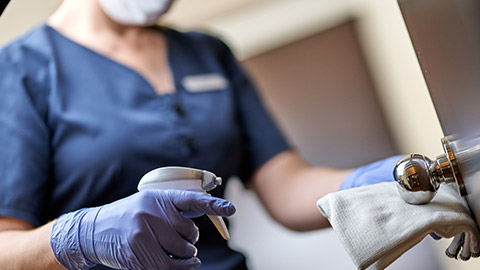
WHS housekeeping in the workplace consists of personal routines designed to improve health and safety, such as cleaning up spills, and keeping walkways, exits, and traffic areas clear. In other words, they are the practices workers employ on a daily basis that help to maintain a safe environment free from hazards. The action a worker undertakes on a daily basis contributes to the safety of everybody in a workplace.
Housekeeping
An untidy workplace can cause injuries, in particular injuries resulting from slips and trips, therefore good housekeeping practices are essential for all workplaces. For example:
- spills on floors should be cleaned up immediately
- walkways should be kept clear of obstructions
- work materials should be neatly stored
- any waste should be regularly removed.
It will be much easier to keep the workplace clean and tidy if it is well laid out with sufficient space for storage and for the movement of people. Space close to workstations should be allocated to allow for the storage of tools and materials that are used frequently, for example providing racks for hand tools above workbenches.
Tidiness throughout the working day can be difficult to maintain in industries where there is rapid production of finished goods and/or waste. In these situations, training all workers in good housekeeping procedures and their co-operation with these procedures is necessary to keep the workplace tidy.
Suitable containers for waste should be conveniently located and regularly emptied. While it may be reasonable to expect workers to leave their immediate work area in a clean and tidy condition at the end of the working day, other options for carrying out the general cleaning of the workplace should be considered, for example engaging cleaners.
(Safe Work Australia, 2011, p. 9)
Each individual workplace will have its own unique requirements regarding WHS housekeeping. Housekeeping may be undertaken in areas such as:
- The physical environment
- Noise levels
- Clutter
- Personal items on a desk
- How everyday items are stored and used
- Whether drinks and food are allowed at stations
- Manual handling
- Log books for driving
- The storage and use of medications
- Personal breaks for meals
- Who is allowed in a work area
To avoid hazards and incidents from occurring, housekeeping may involve:
- Keeping desk clean and tidy
- Keeping common areas clean and tidy
- Keeping walkways clear
- Cleaning up spills or breakages
- Storing materials and equipment safely
- Emptying rubbish/recycling bins regularly
- Reducing unnecessary noise
- Keeping cords covered or secured
- Checking power cables for damage
Reflection
Consider your current WHS housekeeping skills. For example, do you keep your workspace tidy? What could you do to improve your housekeeping skills?
Monitoring housekeeping practices
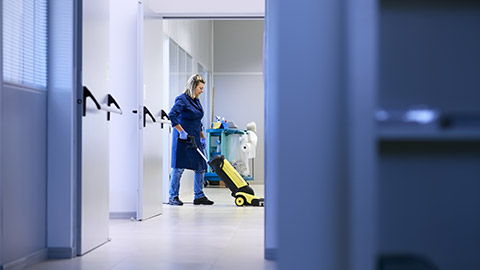
Given the importance of maintaining a safe and clean workspace, housekeeping practices should be monitored regularly. This may involve spot checks and visual inspections of workspaces, storage areas, walkways and doorways, hiring cleaners and keeping up to date with maintenance of equipment, and providing adequate training for staff members so everyone is aware of specific tasks, duties, and requirements. Some housekeeping items should be checked on a daily basis, such as spills, whereas checking first aid kits are adequately stocked, for example, may be more suitable for monthly checks. Some housekeeping practices may be completed by certain personnel, such as cleaning staff or safety checks of fire equipment etc. In this respect, there should be documentation or reports available to check when these were last completed, what was completed, in addition to visual inspections of areas.
Checklists unique to work environment/workplace that can be filled out either according to a schedule, to ensure housekeeping practices are followed, or via spot checks. Your organisation may enlist or assign specific people to undertake inspections or develop inspection or monitoring checklists such as the one below.
Example of a Housekeeping Inspection Checklist
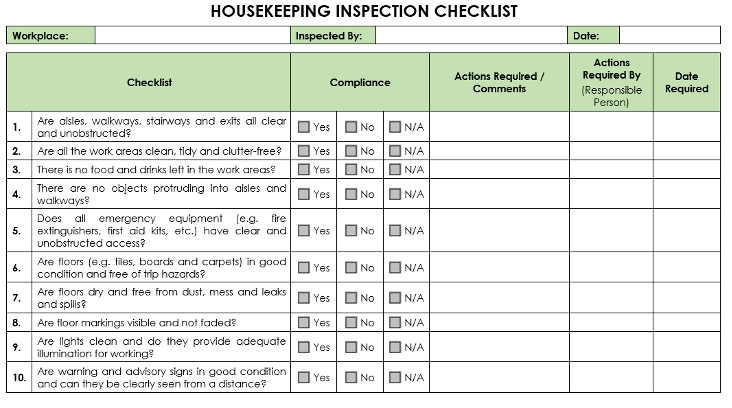
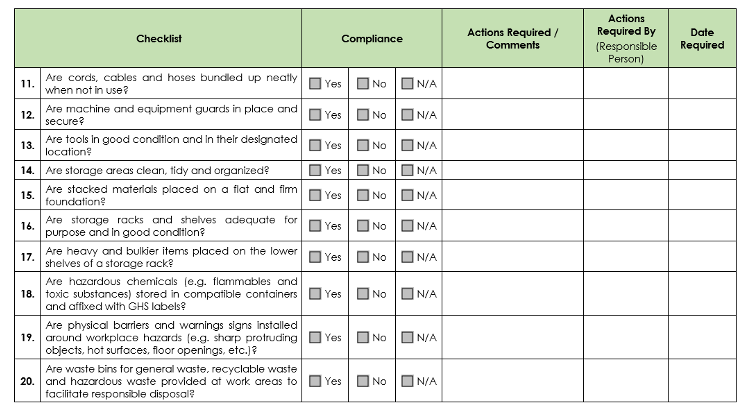
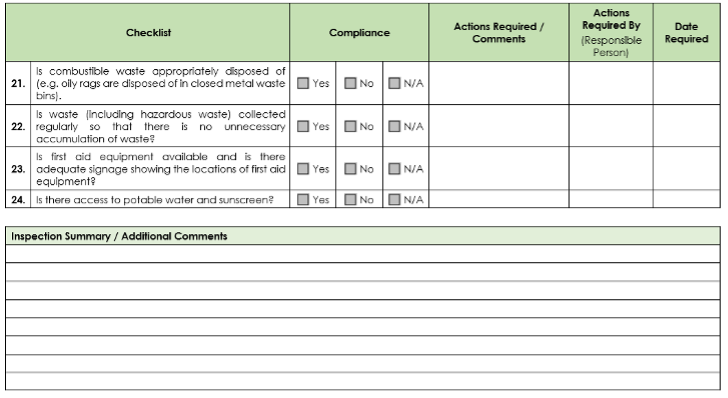
(My Safety Works, n.d.)

Incident and injury reporting are key components of any WHS management system. Incidents refer to any event that has caused or has the potential for injury, ill-health, or damage. These reports can also be indicators of a system weakness and are often used in WHS audits to identify the weak spots in a WHS management system. For example, incident reports can highlight when injuries are occurring due to a hazard, such as an operating technique that needs revision. As such, workers are typically required to report and document all near misses (i.e., situations that could have resulted in an incident or injury) and incidents.
Clear policies and procedures in incident reporting are important for organisations to comply with legislative requirements. Workplaces need to make a report to their state or territory regulators when a notifiable incident occurs, as defined below:
A ‘notifiable incident’ is:
- the death of a person;
- a serious injury or illness of a person; or
- a dangerous incident
arising out of the conduct of a business or undertaking at a workplace.
‘Notifiable incidents’ may relate to any person—whether an employee, contractor or member of the public.
(Safe Work Australia, 2015, p. 2)
As you can see, reporting to WHS regulator is only required for incidents that meet certain criteria set out in the legislation. Not all workplace incidents are notifiable; however, failing to report a notifiable incident can result in large penalties. As such, it is important for organisations to clarify which incidents may be notifiable in order to comply with legislative requirements. When in doubt, respective WHS regulator should be contacted for advice.
State and Territory WHS legislation require all organisations to have well documented incident and injury reporting and follow-up processes. All workers should be trained in the use of these systems and be able to answer the following questions:
- Where can I find an incident form?
- Who is responsible for filling out the incident form?
- Who should the incident form be lodged with?
- What are the follow-up processes once the incident report is lodged?
Reading
Reading E outlines Incident Notification and is a good resource for understanding more on this topic.
The extract below details one organisation’s policy and procedure for critical incidents.
| Critical Incident Report |
|---|
|
Policy Critical incidents involving services, employees or clients will be reported in accordance with procedures to ensure they are efficiently and effectively managed. This policy recognises the importance of the health, safety and well-being of clients, staff, volunteers and the public. A standard system of reporting critical incidents will enhance quality service provision and minimise the risk of harm to clients, staff, volunteers and the public. Procedure All critical incidents must be recorded on the organisation’s Critical Incident Report and include the following actions: At the time of the incident:
Immediately after the incident:
Following the incident:
|
(Adapted from Community Door, n.d.)
If a health administrator is involved in a critical incident, they will need to follow the policies and procedures for their organisation. This typically involves documenting the incident in a critical incident report.
Additionally, investigation procedures should be carried out as soon as possible after an incident to look for causes of the incident and identify any unsafe work practices. This involves recording any physical evidence of the incident and taking notes about the events leading up to the incident, the incident itself, and what occurred after the incident. In the case of a notifiable incident, the Regulator of your State/Territory may request for relevant information and conduct an investigation.
To facilitate the process of incident investigation and reporting, organisations should have standardised forms for incident reporting to guide workers in providing information relevant to the incident. An example of an incident/injury report form, and a case study example of what an incident report might involve, is included below. Analysing information from incident reports and investigations will help to implement appropriate strategies in order to prevent similar incidents in the future. Of course, incident and injury reporting processes are not efficient if workers do not use them. Therefore, all workers should be aware of the reporting process (i.e., trained at induction and regularly provide refresher training). Ultimately, all workers need to know about the importance of completing such documentation and how it should be completed.
Watch
Example Injury/Incident Report Form
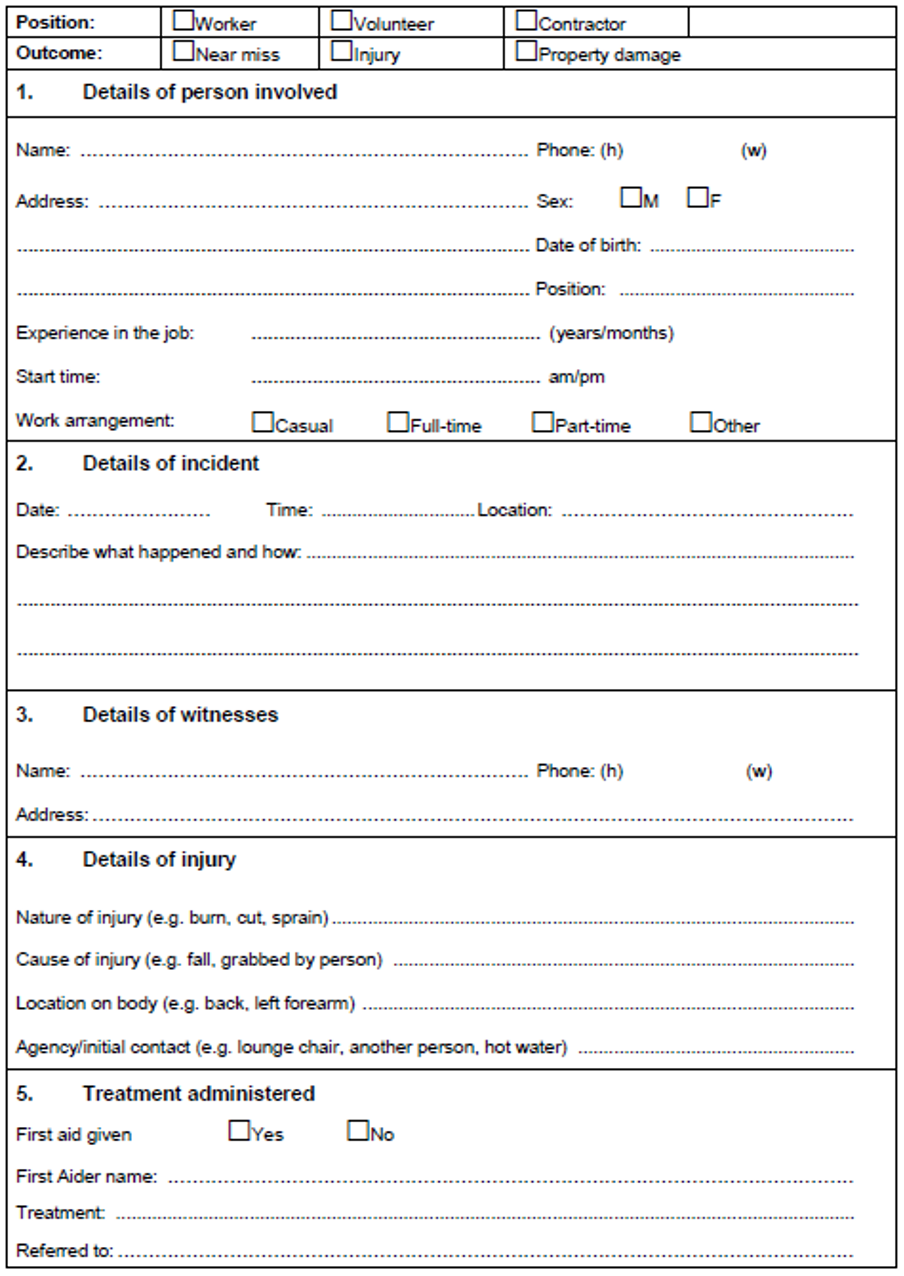
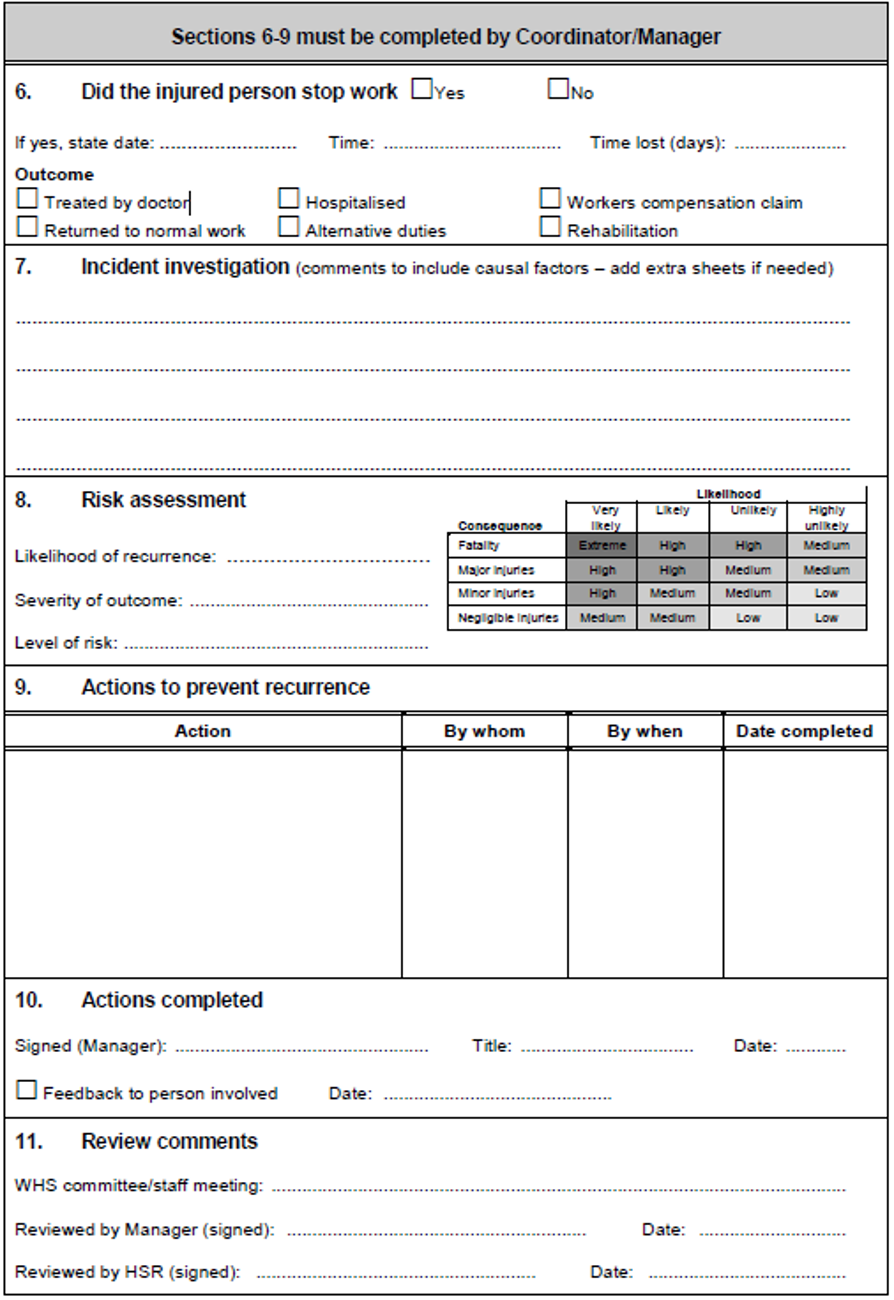
Case Study
Deshawn Smith (26) works at a local allied health organisation, ‘Health Connect’. As he was entering work for a shift at 9:00am, Deshawn was walking around the room and accidentally tripped over a chair leg. Deshawn fell to the ground and landed heavily on his left wrist. He experienced intense pain and was worried that his wrist may have broken in the fall. An ambulance was called immediately by Deshawn’s manager, and Deshawn was later diagnosed with a fractured wrist at the hospital.
The ‘Health Connect’ organisational procedure for documenting injury and incidents is as follows:
- Injuries must be reporting to the Head of Youth Services by phone, fax or email as soon they occur.
- A formal incident report must be completed and submitted to the HR Manager within 24 hours of the incident.
- Copies of the incident must be forwarded to the Managing Director.
Deshawn reported his injury immediately to his line manager and the Head of Allied Health Services by phone. He provided details to his manager, Aileen Wilcox, to help complete the formal incident report. The formal incident report was then submitted to her HR Manager within 24 hours of the incident with copies sent to the Managing Director.
Deshawn sustained a ‘serious injury’ as he required ‘immediate treatment as an inpatient at the hospital’. As a result, the incident was classified as a ‘notifiable incident’ and ‘Health Connect’ were required to report the injury to their state WHS regulators.
|
Critical Incident Report Date of incident: XX/XX/20XX Time of incident: 9:00am Location (include address where applicable): Health Connect Name of person completing form: Deshawn Smith Position of person completing form: Health administrator Contact no: 09 8765 4321 Employees/Volunteers/Management Committee members involved in incident: Clients or community members involved in incident: Description of incident and background (relevant Information leading up to the incident, circumstances, whether the incident was witnessed and other relevant issues): I was coming to work for my shift at ‘Health Connect’. I was walking around the room and accidentally tripped over a chair leg. I fell to the ground and landed heavily on my left wrist. I felt a lot of pain was worried that I broke my wrist. My manager called an ambulance, and I was later diagnosed with a fractured wrist at the hospital. Who was informed of the incident (Manager, Queensland Police, Fire Brigade)? Actions taken to date: (including date and time of contact that Manager and other agencies were informed, as well details of support provided): Follow up action planned: Critical incident report form authorised by: |
Supporting Colleagues to Record Incidents
Workers should also make sure to assist their colleagues to report and record incidents. In particular, senior workers have a duty of care towards their colleagues to support them through the process of reporting incidents in line with any WHS legislative requirements the employer may have. This support may involve helping the worker to fill out correct forms in the appropriate timeframes, and ensure the forms go to the correct departments and personnel. Senior workers should also ensure that all workers know how to complete required WHS documentation, such as job checklists, schedules, and workplace inspection checklists.
Senior workers can help other workers to complete appropriate report forms and additional WHS documentation by:
- Supplying the relevant forms and making themselves available for the worker to ask questions or clarify any information not understood
- Explaining the process of submitting forms
- Explaining any medical requirements, such as the need for a doctor’s certificate or clearance form
- Explaining how any invoices associated with an injury are produced
- Explaining any follow up procedures
- Providing contact information of any relevant staff members, such as the Health and Safety representatives
- Providing information in another language if necessary or contacting interpreters
Watch
In this section of the module you have learned about providing information about WHS policies and procedures, and about identified hazards and risks, including outcomes, with your work team. Housekeeping practices, and how to monitor them, were outlined as well as information pertaining to incident reporting according to workplace procedures and legislative requirements.
Community Door (n.d.). Equity, anti-discrimination and workplace harassment policy and procedure example. https://communitydoor.org.au/resources/administration/policies-procedures-templates#0-text-nav-item-2
Hirshi, A. (2019). [Photograph of two women in office wear at a meeting desk holding a tablet and having a discussion]. Unsplash. https://unsplash.com/photos/K0c8ko3e6AA
My Safety Works. (n.d.). Workplace Housekeeping Checklist. https://mysafetyworks.com.au/product/workplace-housekeeping-checklist/
Safe Work Australia. (2011). Managing the work environment and facilities Code of Practice. https://www.safeworkaustralia.gov.au/system/files/documents/1702/managing_work_environment_and_facilities2.pdf
Safe Work Australia. (2018). Model Code of Practice: How to manage work health and safety risks. https://www.safeworkaustralia.gov.au/doc/model-code-practice-how-manage-work-health-and-safety-risks
Safe Work Australia. (2023). Work health and safety consultation, cooperation and coordination Code of Practice. https://www.safeworkaustralia.gov.au/doc/model-code-practice-work-health-and-safety-consultation-cooperation-and-coordination
Safe Work Australia. (2020). Incident Notification Information Sheet. https://www.safeworkaustralia.gov.au/resources-and-publications/guidance-materials/incident-notification-information-
SafeWork South Australia. (2014). Community Workers – Work Health and Safety Guidelines. https://www.safework.sa.gov.au/__data/assets/pdf_file/0003/140772/Community-Workers-work-health-and-safety-guidelines.pdf
WorkSafe A.C.T. (2010). Record keeping. https://www.worksafe.act.gov.au/health-and-safety-portal/managing-safety/record-keeping
WorkSafe Victoria. (2006). Working safely in community services. http://www.daru.org.au/wp/wp-content/uploads/2013/07/Working_Safely_in_Community_Services-OHS-information-packl.pdf
My Safety Works. (n.d.). Workplace Housekeeping Checklist. https://mysafetyworks.com.au/product/workplace-housekeeping-checklist/
